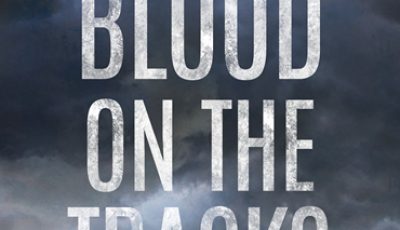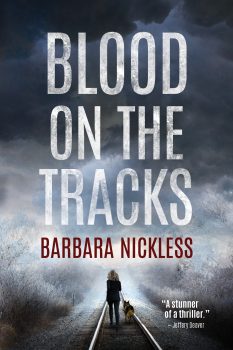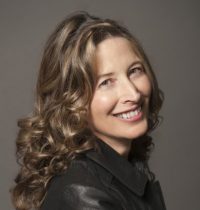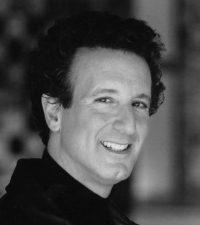

Blood on the Tracks by Barbara Nickless
 By Jon Land
By Jon Land
Writing and publishing a first novel kind of reminds me of the great line from Samuel Johnson about a dog walking on its hind legs: “It is seldom done well, but you are surprised to see it being done at all.”
Well, Barbara Nickless does it, and very well at that, in BLOOD ON THE TRACKS. Her debut thriller makes splendid use of both primary and secondary research in fashioning a well-executed tale that features a unique backdrop. Nickless’s style is reminiscent of Nevada Barr, but I also saw some traces of C.J. Box and even the late great Tony Hillerman.
Indeed, these days building your brand as a thriller writer means staking out a ground and making it your own. That’s what Nickless does in taking us into the little known world of railroad cops, and the kind of work they do beyond securing AMTRAK stations from potential terrorists. I sat down with Barbara recently to pick her brain about where the idea originated and how she assembled such diverse material into a coherent story.
I have to start with the whole notion of making your hero/heroine a railroad policeman. Could you tell us why you did and where you got the idea?
A few years ago, I read a book by modern-day hobo Eddy Joe Cotton (called, appropriately, Hobo), and I became fascinated with the homeless people who catch out on freight trains and ride them all around the country. Every hobo is familiar with the bulls—the railroad cops. When I learned that railway police have the same jurisprudence as traditional police, it was a eureka moment. I’ve always loved crime fiction; now I had an idea for a police procedural, but with a gritty twist.
Plot wise, BLOOD ON THE TRACKS delves into the notion of a cultish band of killers, kind of like murderous hobos, who call the rails home. That’s actually based on fact, isn’t it?
There really is a gang called the Freight Train Riders of America. FTRA was likely started by a group of Vietnam vets as a way to create camaraderie among rail riders. A wonderful idea. But at some point, the group was hijacked by criminal elements. A lot of FTRA’s members have been linked to crimes ranging from fraud and theft to serial murder.
Another terrific element of the book is Sydney Parnell’s canine partner, Clyde, who reminded me of a kind of mix between Rin-Tin-Tin and Mas, title character from a recent film I really liked. What made you go in that direction when conceiving the story?
I guess I ascribe to the Mulligan stew theory of plotting—throw in whatever you have on hand. If something captures my interest while I’m writing a book, there’s a good chance it will find its way into my story. I learned about Military Working Dogs while researching Marines and the Iraq war. I couldn’t can say no to these incredible heroes. The fact that they also suffer PTSD made their stories even more poignant.
You rely a bit on what has become a staple of the genre, that being a hero haunted by experiences from her past, which you handled very well. How did you keep that from feeling clichéd?
Thank you for saying that! Hemingway said that when beginning a story, start by writing one true sentence, and that’s what I tried to do while creating Sydney’s character. Her struggles are based on the very real distress experienced by our veterans—from the Civil War on up through our current operations. I took an ordinary young woman, dropped her into Mortuary Affairs in Iraq, then let everything else come naturally from her experiences. I’m glad it worked!
You’re a writer who likes to directly experience life with the kind of cop hero Sydney Parnell is. How have those experiences affected your writing?
I’ve really enjoyed all the first-hand research I’ve gotten to do while writing this book. Police ride-alongs, the FBI Citizens Academy, weapons training, visiting medical examiners and touring crime labs and even going to hobo camps and railroad repair shops. While I’m a firm believer in using research books to lay the groundwork, nothing can compare to the visceral experience of actually going to various places, talking to the people, taking in the sounds and sights and smells.
I noticed that your blog includes several entries on PTSD and that among the causes you support are several dealing with veterans. What are the origins of that and how does that particular passion of yours woven into BLOOD ON THE TRACKS?
My father was a WWII vet—a B-24 bomber pilot. And my uncle was a POW in the same war. When I was young, my family sat at the dinner table every night and watched the news footage of Vietnam. I grew up thinking that war wasn’t something you talked about, but it was very much a presence in our home. When America went into Afghanistan and then Iraq, I was eager to learn as much about the experience of war as I could. But what really affected me were the kinds of injuries and traumas our veterans were returning home with. That was a story I wanted to tell.
Who would you name as some of your greatest influences in the thriller community and whose style do you most emulate?
There are so many! The first thriller novel I read was Martin Cruz Smith’s Gorky Park, and I’ve read and loved every book he’s written since. Dennis Lehane’s Mystic River was a punch to the gut. To mention just a few more authors: John le Carre, Jeffery Deaver, Karin Slaughter, Robert Crais, Mo Hayder, Ken Follett and some guy named Jon Land. I’ve learned something from all of these writers.
BLOOD ON THE TRACKS is framed in first person, told entirely from Sydney’s point of view. What’s the best and worst thing about writing from your hero’s POV?
The best thing about writing in first person POV is how completely you get to inhabit that character and see the world through their eyes. Sydney became a very big part of my life—her world view became mine. One example—about halfway through writing Blood on the Tracks, my husband noticed that my language had gone seriously downhill. Sydney is both a cop and a former Marine, so she naturally uses rough language during the intensity of conflict or as a way to relieve stress. Without intending to, I hopped right on board with that.
The hardest part of using a single POV, for me, is losing the ability to create suspense by showing the reader what the bad guys are up to.
I want to read you this quote from a review posted on Amazon: First book review from me for Amazon. What a great read and even better that it was an amazon first book. If you ever wondered how veterans with PTSD think and act, this would be a great start. Although it is fiction, I am an Afghanistan Veteran and characters were relatable when their anxiety peaked and the PTSD was triggered. Some of the flashbacks were described in such detail I would get chills. Describe how reading a review like that makes you feel.
Thank you for sharing this. This, for me, is what writing is all about. I’ve heard from a number of veterans or their families, thanking me for letting people know what their struggles are like. Some emails have moved me to tears. I can’t imagine anything more rewarding.
Obligatory final question: What are you working on next, and tell us something about it you haven’t shared with anyone yet?
I am currently working on the second book in the Sydney and Clyde series, DEAD STOP. What no one knows outside of my beta readers is that this book starts with a bang intended to create the worst possible kind of trouble for Sydney and her war-troubled K9 partner.
*****
 Barbara worked as a raptor rehabilitator, instructional designer, technical writer, astronomy instructor, sword fighter and piano teacher before turning to writing. Now an award-winning author, she lives in Colorado where she loves to snowshoe, cave, hike and drink single malt Scotch—usually not at the same time. She is the author of the Special Agent Parnell series featuring a railroad cop and her K9 partner.
Barbara worked as a raptor rehabilitator, instructional designer, technical writer, astronomy instructor, sword fighter and piano teacher before turning to writing. Now an award-winning author, she lives in Colorado where she loves to snowshoe, cave, hike and drink single malt Scotch—usually not at the same time. She is the author of the Special Agent Parnell series featuring a railroad cop and her K9 partner.
To learn more about Barbara, please visit her website.
 Jon Land is the award winning and USA Today bestselling author of 38 novels, including seven titles in the critically acclaimed Caitlin Strong series, the most recent of which, Strong Light of Day, will to be followed this October by Strong Cold Dead. Land has also teamed with Thrillermaster Heather Graham on a new sci-fi series, the first of which, The Rising, will be published by Forge in January of 2017.
Jon Land is the award winning and USA Today bestselling author of 38 novels, including seven titles in the critically acclaimed Caitlin Strong series, the most recent of which, Strong Light of Day, will to be followed this October by Strong Cold Dead. Land has also teamed with Thrillermaster Heather Graham on a new sci-fi series, the first of which, The Rising, will be published by Forge in January of 2017.
To learn more about Jon, please visit his website.
- THE GOD IN THE SEA with Paul Kemprecos - April 4, 2024
- FOR WORSE with L. K. Bowen - April 4, 2024
- HIT AND RUN with Vincent Zandri - April 4, 2024
